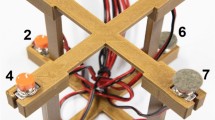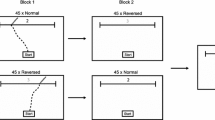Abstract
The current study investigated whether children’s mental representations of numbers are organized spatially at the onset of formal schooling using a manual-pointing task. First-graders (N = 77) saw four numbers (1, 3, 7, 9) presented randomly in four spatial positions (extreme left, left, right, extreme right) on a touch screen. In a Go/No-Go task, children were asked to press the appearing numbers as fast and accurately as possible, but only when the numbers were “smaller” (or “larger” in a different block) than 5. Results indicated that response times were significantly affected by the spatial position in which the different numbers were presented. Response times for small numbers (1 and 3) increased and response times for large numbers (7 and 9) decreased, the more they were presented towards the right side of the screen. These findings suggested that first-graders spontaneously employed a spatial number representation that was oriented from left to right. Furthermore, this left-to-right organization could not be easily changed by priming a different direction. Our findings indicate that even young children map numbers continuously onto space.




Similar content being viewed by others
References
Adachi, I. (2014). Spontaneous spatial mapping of learned sequence in chimpanzees: Evidence for a SNARC-like effect. PLoS One, 9, e90373.
Bächtold, D., Baumüller, M., & Brugger, P. (1998). Stimulus–response compatibility in representational space. Neuropsychologia, 36, 731–735.
Berch, D. B., Foley, E. J., Hill, R. J., & Ryan, P. M. (1999). Extracting parity and magnitude from Arabic numerals: Developmental changes in number processing and mental representation. Journal of Experimental Child Psychology, 74, 286–308.
Briars, D., & Siegler, R. S. (1984). A featural analysis of preschoolers’ counting knowledge. Developmental Psychology, 20, 607–618.
Bruner, J. S., Olver, R. O., & Greenfield, P. M. (1966). Studies in cognitive growth. New York: Wiley.
Bulf, H., de Hevia, M. D., & Macchi-Cassia, V. (2016). Small on the left, large on the right: Numbers orient preverbal infants’ visual attention onto space. Developmental Science, 19, 394–401.
Calabria, M., & Rossetti, Y. (2005). Interference between number processing and line bisection: A methodology. Neuropsychologia, 43, 779–783.
de Hevia, M. D., Girelli, L., Addabbo, M., & Macchi Cassia, V. (2014). Human infants’ preference for left-to-right oriented increasing numerical sequences. PLoS One, 9, e96412.
Dehaene, S., Bossini, S., & Giraux, P. (1993). The mental representation of parity and number magnitude. Journal of Experimental Psychology: General, 122, 371.
Drucker, C. B., & Brannon, E. M. (2014). Rhesus monkeys (Macaca mulatta) map number onto space. Cognition, 132, 57–67.
Ebersbach, M. (2015). Evidence for a spatial–numerical association in kindergartners using a number line task. Journal of Cognition and Development, 16, 118–128.
Fias, W. (2001). Two routes for the processing of verbal numbers: Evidence from the SNARC effect. Psychological Research, 65, 250–259.
Fias, W., Brysbaert, M., Geypens, F., & d’Ydewalle, G. (1996). The importance of magnitude information in numerical processing: Evidence from the SNARC effect. Mathematical Cognition, 2, 95–110.
Fischer, M. H. (2001). Number processing induces spatial performance biases. Neurology, 57, 822–826.
Fischer, M. H., Castel, A. D., Dodd, M. D., & Pratt, J. (2003). Perceiving numbers causes spatial shifts of attention. Nature Neuroscience, 6, 555–556.
Fischer, M. H., & Shaki, S. (2014). Spatial associations in numerical cognition: From single digits to arithmetic. Quarterly Journal of Experimental Psychology, 67, 1461–1483.
Fischer, M. H., Shaki, S., & Cruise, A. (2009). It takes just one word to quash a SNARC. Experimental Psychology, 56, 361–366.
Galfano, G., Rusconi, E., & Umiltà, C. (2006). Number magnitude orients attention, but not against one’s will. Psychonomic Bulletin and Review, 13, 869–874.
Gevers, W., Verguts, T., Reynvoet, B., Caessens, B., & Fias, W. (2006). Numbers and space: A computational model of the SNARC effect. Journal of Experimental Psychology: Human Perception and Performance, 32, 32–44.
Göbel, S. M., Shaki, S., & Fischer, M. H. (2011). The cultural number line: a review of cultural and linguistic influences on the development of number processing. Journal of Cross-Cultural Psychology, 42, 543–565.
Hoffmann, D., Hornung, C., Martin, R., & Schiltz, C. (2013). Developing number–space associations: SNARC effects using a color discrimination task in 5-year-olds. Journal of Experimental Child Psychology, 116, 775–791.
Hubbard, E. M., Piazza, M., Pinel, P., & Dehaene, S. (2005). Interactions between number and space in parietal cortex. Nature Reviews Neuroscience, 6, 435–448.
Ishihara, M., Jacquin-Courtois, S., Flory, V., Salemme, R., Imanaka, K., & Rossetti, Y. (2006). Interaction between space and number representations during motor preparation in manual aiming. Neuropsychologia, 44, 1009–1016.
Kamawar, D., LeFevre, J., Bisanz, J., Fast, L., Skwarchuk, S. L., Smith-Chant, B. L., & Penner-Wilger, M. (2010). Knowledge of counting principles: How relevant is order irrelevance? Journal of Experimental Child Psychology, 105, 138–145.
Knudsen, B., Fischer, M. H., & Aschersleben, G. (2015). Development of spatial preferences for counting and picture naming. Psychological Research, 79, 939–949.
Kosslyn, S. M. (1978). The representational-development hypothesis. In P. A. Ornstein (Ed.), Memory development in children (pp. 157–189). Hillsdale, NJ: Erlbaum.
McCrink, K., Caldera, C., & Shaki, S. (2017). The early construction of spatial attention: Culture, space, and gesture in parent–child interactions. Child Development. doi:10.1111/cdev.12781.
McCrink, K., & Opfer, J. E. (2014). Development of spatial–numerical associations. Current Directions in Psychological Science, 23, 439–445.
Mills, K. J., Rousseau, B. R., & Gonzalez, C. L. (2014). A cross-sectional developmental examination of the SNARC effect in a visually-guided grasping task. Neuropsychologia, 58, 99–106.
Nuerk, H.-C., Patro, K., Cress, U., Schild, U., Friedrich, C. K., & Goebel, S. M. (2015). How space-number associations may be created in preliterate children: six distinct mechanisms. Frontiers in Psychology, 6, 215.
Opfer, J. E., Thompson, C. A., & Furlong, E. E. (2010). Early development of spatial numeric associations: Evidence from spatial and quantitative performance of preschoolers. Developmental Science, 13, 761–771.
Patro, K., Fischer, U., Nuerk, H.-C., & Cress, U. (2016). How to rapidly construct a spatial–numerical representation in preliterate children (at least temporarily). Developmental Science, 19, 126–144.
Patro, K., & Haman, M. (2012). The spatial–numerical congruity effect in preschoolers. Journal of Experimental Child Psychology, 111, 534–542.
Piaget, J., & Inhelder, B. (1956). The child’s conception of space (F. J. Langdon & J. L. Lunzer, Trans.). New York: Norton. (Original work published 1948).
Ranzini, M., Dehaene, S., Piazza, M., & Hubbard, E. (2009). Neural mechanisms of attentional shifts due to irrelevant spatial and numerical cues. Neuropsychologia, 47, 2615–2624.
Ristic, J., Wright, A., & Kingstone, A. (2006). The number line reflects top-down control. Psychonomic Bulletin and Review, 13, 862–868.
Rugani, R., Vallortigara, G., Priftis, K., & Regolin, L. (2015). Number-space mapping in the newborn chick resembles humans’ mental number line. Science, 347(6221), 534–536.
Shaki, S., & Fischer, M. H. (2008). Reading space into numbers—a cross-linguistic comparison of the SNARC effect. Cognition, 108, 590–599.
Shaki, S., Fischer, M. H., & Petrusic, W. M. (2009). Reading habits for both words and numbers contribute to the SNARC effect. Psychonomic Bulletin and Review, 16, 328–331.
van Galen, M. S., & Reitsma, P. (2008). Developing access to number magnitude: A study of the SNARC effect in 7-to 9-year-olds. Journal of Experimental Child Psychology, 101, 99–113.
Walsh, V. (2003). A theory of magnitude: Common cortical metrics of time, space, and quantity. Trends in Cognitive Sciences, 7, 483–488.
Wood, G., Nuerk, H.-C., Willmes, K., & Fischer, M. H. (2008). On the link between space and number: A meta-analysis of the SNARC effect. Psychology Science, 50, 489–525.
Wynn, K. (1990). Children’s understanding of counting. Cognition, 36, 155–193.
Zebian, S. (2005). Linkages between number concepts, spatial thinking, and directionality of writing: The SNARC effect and the reverse SNARC effect in English and Arabic monoliterates, biliterates, and illiterate Arabic speakers. Journal of Cognition and Culture, 5, 165–190.
Author information
Authors and Affiliations
Corresponding author
Ethics declarations
Ethical approval
All procedures performed in the current study involving human participants were in accordance with the ethical standards of the institutional and/or national research committee and with the 1964 Helsinki declaration and its later amendments or comparable ethical standards.
Conflict of interest
The authors declare that they have no conflict of interest.
Additional information
This research was supported by a Research Grant from the Swiss National Science Foundation # PP00P1_150486. We are grateful to Lisa Heid and Sarah Dubach for their support with data collection.
Rights and permissions
About this article
Cite this article
Möhring, W., Ishihara, M., Curiger, J. et al. Spatial–numerical associations in first-graders: evidence from a manual-pointing task. Psychological Research 83, 885–893 (2019). https://doi.org/10.1007/s00426-017-0904-4
Received:
Accepted:
Published:
Issue Date:
DOI: https://doi.org/10.1007/s00426-017-0904-4




